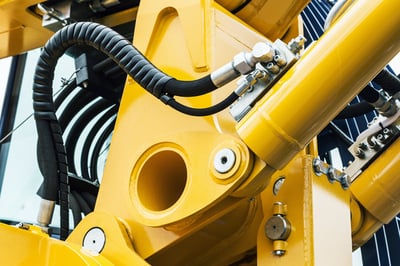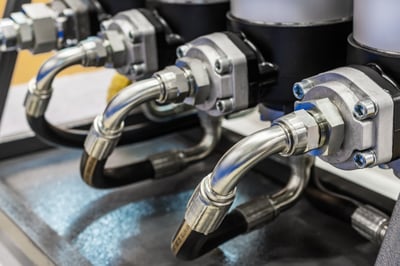Braided Hydraulic Hose
Wire braided hydraulic hose incorporates one or two high tensile steel wires which are woven and crossed to overlap each other over a synthetic rubber or elastomeric hose. The wire braiding is performed on machines which wind the wire in a crisscross pattern around the hose. This type of overlapping braiding of the wire allows for flexibility to make tight bends and significantly improves burst resistance. Unlike spiral wound hose, braided hydraulic hoses withstand more tensile stress, allowing it to achieve these tighter bend radiuses.Braided hose is the most popular hydraulic hose, primarily due to its excellent strength and flexibility. While available in an extensive selection of pressure ratings and sizes, the pressure rating is reduced with increases in inner tube ID. This equates to the hose having a four to one safety factor, with working pressure rated at a quarter of burst pressure.
Spiral Wound Hydraulic Hose
Spiral wound hydraulic hose is more rigid, commonly used in high pressure applications and where there are no significant space limitations that require the hose to be overly flexible. A spiral wound hose comprises of four or six wires depending on the application, helically wrapped and stacked on top of each other, rather than wound like a braided hose. Spiral hose incorporates high-tensile wire which provides the hydraulic hose with exceptional strength, yet it is also very inflexible, with a minimum bend radius. However, a smaller diameter allows for a tighter bend radius.
For instance, a small diameter spiral wound hydraulic hose can operate at 3000 PSI with just one layer of spiral, making it inherently flexible. Where a larger diameter hose may require four layers of spiral wire to handle 3000 PSI, which will make it very rigid with a highly reduced bend radius, resulting in less routing flexibility.
Spiral hydraulic hose has an extremely high resistance to pressure spikes, which is required for many large diameter, high-pressure applications.
Braided versus Spiral: What to Choose
It really comes down to gains and losses. If the application calls for very high-pressure hose that will experience higher impulses, then a spiral wound hose is the best choice. But you will sacrifice flexibility and make it difficult to build a system in a small space or connect to (devices) that have frequent articulating movement, such as a backhoe or robotic arm. In these applications, braided hose may be the best choice. In fact, according to Tech Briefs: “Robotic system designers should choose the right power source for the job. Often, electric motors are chosen without thinking about the benefits of hydraulics or pneumatics. For applications where precise control of large forces and smooth motion are required, or applications that require “forgiveness” in the motion, fluid power can deliver significant benefits compared to electromechanical motion.”
Take the example of using the same hose construction type in a braided hose, and then in a spiral wound hose, where flexibility is reduced as the diameter increases.
- A ¼ inch ID 1-wire braided hose that’s rated for 3200 psi has a very flexible bend radius of 1 ½ inches. However, the same hose type that has a 1-inch ID and is rated for 1300 psi, has a drastically reduced bend radius of 5 ½ inches.
- In the case of spiral hose, a ¼ inch ID would be rated for 5100 psi and have a minimum bend radius of only 5 inches, compared to the 1 ½ inches for a braided hose. And where the 1-inch ID spiral wound hose would still have a pressure rating of 5100 psi, but at 1 inch ID has a minimum bend radius of only 12 inches. It’s almost like bending a thick steel pipe. You’ll only get so much bend before it cracks. Yet, the spiral hose clearly can withstand much higher pressures and pressure spikes.
Choosing the Wrong Hose Type Can Cause Catastrophic Failure
Selecting the wrong hydraulic hose or improper installation and configuration can cause catastrophic failure. And it can happen almost immediately. If the minimum bend radius exceeded, or 1 or 2 braided hose is used under very high pressure, where a 4 or 6 wire spiral hose was the right choice., this can lead to leaks at the bend or cause the hose to burst. In either case, dangerous fluid can be quickly expelled causing damage to equipment or personnel.
Always check the manufacturer’s recommended bend radius and route the hose in a way that does not exceed the recommendation. If the hose bend radius is exceeded while in a suction or vacuum, it will likely become flat in the area of the bend, restricting flow, or even causing the hose to kink. It’s like bending a kink in your garden hose, but much worse something has to give.
Conclusion
Braided hoses are used in low to medium, less intensive pressure applications such as engines, hydraulic lifts and return lines. Spiral hoses are best for higher pressures and frequent pressure surges such as in hydrostatic drives, large off-road earth moving dump trucks or mining excavators. Simply put, braided hoses are ideal for high pressures requiring tight bend radius, where spiral hoses are best for extremely high pressure, high impulse applications.
Sources Include:

